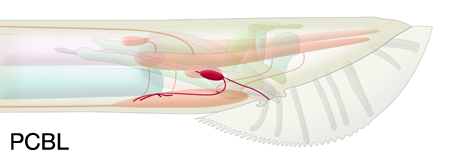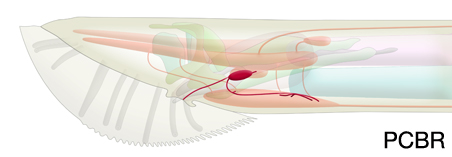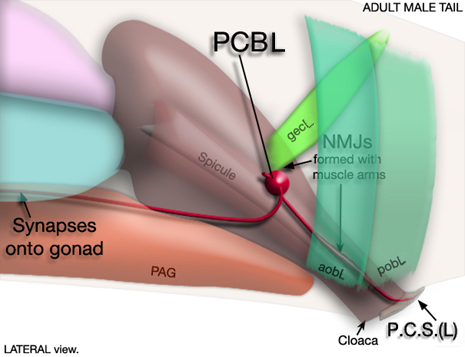Type: Sensory neuron, motor neuron
Male Wiring Project: PCBL,
PCBR
In Wormbase: PCB, PCBL, PCBR
Lineage: Y.plpa, Y.prpa
Location: L/R Cloacal ganglia
Description: One of 3 bilateral pairs of male specific sensory neurons (PCAL/R, PCBL/R, PCCL/R) that innervate the left and right post-cloacal sensilla (P.C.S.) in the male tail (Sulston et al., 1980). Along with SPC neuron, they also innervate the male gonad (Jarrell et al., 2012; Male Wiring Project). Additonally, these neurons have outputs onto gubernacular erector (gec) and the oblique (aob, pob) muscle arms (see Male Wiring Project) and so may have motor as well as sensory function.
Neurotransmitter/Neuropeptide:
- Acetylcholine
(Garcia et al., 2001)
Innexin expression:
Make gap junctions mainly to HOA, HOB and SPD. Less frequent gap junctions to each other, AVG, CP09, CA05, CA06, R2B, PCC, PVV and PVX. PCBL also makes gap junctions to dspL and dBWML22 (see Male Wiring Project)
Function: The P.C.S. functions redundantly with the hook in several steps of male mating behavior: locating the vulva, promoting backing over the vulval region and inducing spicule prodding behavior which is used to precisely locate the vulval opening. P.C.S. neurons are responsible for coordinating the sensing of vulva position with spicule prodding; they sense vulva position using sensory processes that project posteriorly from the cloacal opening. They then stimulate oblique and gubernaculum muscles, which in turn, lead to twitch contractions in spicule protractors via gap junctions. The twitching in these muscles are transduced into prodding via hemidesmosome attachments between the protractor muscles and spicule cuticle. Once prodding leads to partial penetration, SPC neurons induce full insertion.
(LeBoeuf et al., 2014; Garcia et al., 2001; Liu and Sternberg, 1995; see Mating Movie)
-
Along with SPC, P.C.S. neurons may regulate sperm movement. Ablation of PCB along with SPC decreases sperm ejaculation significantly. The remaining sperm release may be due to PCA (LeBoeuf et al., 2014) |



|

